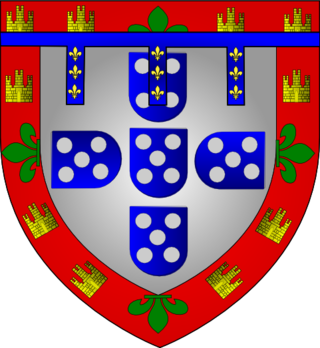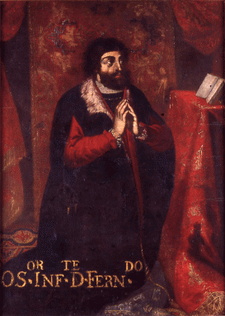
Afonso V, known by the sobriquet the African, was King of Portugal from 1438 until his death in 1481, with a brief interruption in 1477. His sobriquet refers to his military conquests in Northern Africa.
Ferdinand of Portugal may refer to:

The Most Serene House of Braganza, also known as the Brigantine dynasty, is a dynasty of emperors, kings, princes, and dukes of Portuguese origin which reigned in Europe and the Americas.

Eleanor of Viseu was a Portuguese infanta (princess) and later queen consort of Portugal. She is considered one of her country's most notable queens consort and one of the only two who were not foreigners. To distinguish her from other infantas of the same name, she is commonly known as Eleanor of Viseu or Eleanor of Lancaster. In Portugal, she is known universally as Rainha Dona Leonor.
John of Portugal is the name of several Portuguese kings and other members of the Portuguese Royal Family:

Infante John, Constable of Portugal was a Portuguese infante (prince) of the House of Aviz, Constable of Portugal and master of the Portuguese Order of St. James (Santiago). In Portugal, he is commonly referred to as the O Infante Condestável.
Eleanor or Leonor of Portugal is the name of:

Eleanor of Aragon was Queen of Portugal from 1433 to 1438 as the spouse of King Edward. After Edward's death, she served as regent in 1438-1440 for her son Afonso V. She was the daughter of Ferdinand I of Aragon and Eleanor of Alburquerque.

The Military Order of Saint James of the Sword is a Portuguese order of chivalry. Its full name is the Ancient, Most Noble and Enlightened Military Order of Saint James of the Sword, of the Scientific, Literary and Artistic Merit.
Isabella of Portugal (1503–1539). was Holy Roman Empress and Queen of Spain as the wife of Charles V & I.
Constable of Portugal was an office created by King Ferdinand I of Portugal in 1382, to replace the High Standard-bearer (Alferes-Mor) as the head of the Portuguese Military. It was also referred as the Constable of the Kingdom.
A donatário, sometimes anglicized as donatary, was a private person — often a noble — who was granted a considerable piece of land by the Kingdom of Portugal. The king exempted these titleholders from normal colonial administration; the donatários were comparable to a royal governor or a British Lord Proprietor. As the donataria were often captaincies, the position is also translated as captain.

Duke of Viseu was a Portuguese Royal Dukedom created in 1415 by King John I of Portugal for his third male child, Henry the Navigator, following the conquest of Ceuta.

John, Prince of Portugal was a Portuguese infante, son of Afonso V and Isabella of Coimbra. He was born heir to the throne in 1451, but he died young during the same year. The title of Prince of Portugal then passed again to Infante Ferdinand, Duke of Viseu, his uncle.

Infanta Beatriz of Portugal was a Portuguese infanta, daughter of John, Constable of Portugal, and Isabella of Barcelos, a daughter of Afonso I, Duke of Braganza.

Duke of Beja was an aristocratic Portuguese title and royal dukedom, associated with the Portuguese Royal House.

Infante João of Viseu was the older son of Infante Fernando, Duke of Viseu and of his wife Infanta Beatrice of Portugal.

Infante Diogo of Viseu (1450–1484) was the second son of Ferdinand, Duke of Viseu, and his wife Beatriz, Duchess of Viseu.
The Ínclita Geração is a term commonly used by Portuguese historians to refer to a group of 15th-century infantes (princes) of the House of Aviz, specifically the sons of King John I of Portugal and his wife Philippa of Lancaster : the future king Edward of Portugal; the future regent Peter of Coimbra; Prince Henry the Navigator; the constable John of Reguengos; and the martyr Ferdinand the Holy Prince.














